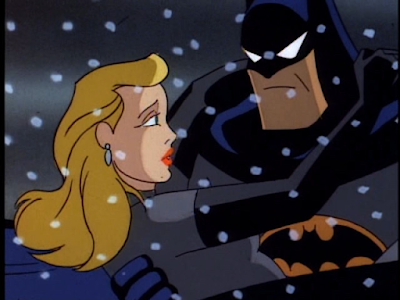We've finally returned to the intended "Next issue-!" point from three-and-a-half years ago and it's almost extra appropriate, since the Catwoman episodes are always ones that seem like they're intentionally part of the larger picture, unlike things like See No Evil or even The Laughing Fish. Those latter two are or could be one-offs, without character development that is the essence of the relationship between Bruce Wayne and Selina Kyle and, in turn, The Batman and Catwoman. That personal connection is what makes episodes like Cat Scratch Fever stand out in the long view. Not only do we begin with Selina being charged for the crimes she committed in The Cat and the Claw, but we have references to their changing circumstances made by Maven, Alfred, and Bruce. Indeed, Alfred even suggests that Bruce should start dating a known criminal, even if she is one, as the judge states in the opening scene, who committed crimes for a just cause. Of course, that also highlights the real world problem with America's two-tiered justice system, in that a wealthy, White woman had 25 years in prison changed to 5 years of probation. That's something that wouldn't have happened to anyone a) poorer and b) darker. Of course, that's a theme that's very much outside the realm of what Timm and Co. were aiming for, but it's a context that can easily be laid over this episode, in a similar vein to the radio broadcast talking about "record lows" in temperature, which is no longer the case in our world.
We also see the return of Daggett Industries, which we first saw in Feat of Clay and is now even more of a menace to the general public. This was the replacement for the goofy Shreck Corporation of Batman Returns, in which a huge department store was a threat to the public, whereas Daggett is at least an experimental lab and chemical company that makes destructive substances for profit. In that way, the series was trying to draw a line between the visual style that they had borrowed from Tim Burton's films and its often absurdist approach to the mythos and setting. Similarly, Selina clearly drew a line between her two identities when it came the aforementioned relationship. Bruce was firmly placed in the "friend zone", while Catwoman feels free to make a pass at The Batman whenever the opportunity presents. It's a similar approach to the line that Bruce clearly draws when Alfred's suggestion about a date is rebuffed. In his eyes, Bruce Wayne is one thing and The Batman is something else entirely; an opinion that Selina clearly shares. The statement is made that "You won't see Selina Kyle anywhere near Daggett Labs" before Catwoman makes an appearance at the Labs in the very next scene. It's a compartmentalization that is similar, but rooted in very different origins, as Bruce's comes from trauma and Selina's from a desire to help things that can't help themselves. At the same time, they're quite similar, as both are pursuing justice outside the law, but one is willing to overtly commit crimes in order to do it, while the other is more adept at toeing the line where necessary.
Speaking of visual style, they stuck with the imagery of Batman Returns and the Michelle Pfeiffer appearance, which is also reminiscent of Julie Newmar from the 60s TV series. Of course, the most famous version in the comics is the 1970s brunette, drawn by artists like Irv Novick and Ross Andru, usually with Dick Giordano's inks. And, interestingly, despite Frank Miller's Return of the Dark Knight having been the inspiration for Burton's films and, subsequently, the Animated Series, they avoided the short-haired street criminal approach that Miller presented in Batman: Year One and which later became the dominant motif (regardless of hair color or style) in presentations like Gotham. It's a nod to just how many interpretations of the main character and his surrounding cast can be made and still carry the essential identity of what the story. That's a character and a concept with depth, which is why he's been the most enduring and popular of DC's creations (and, of course, not being a demigod, even if he is a billionaire, super martial artist, and genius detective.) In the one questionable editing moment, he's such a genius that he somehow retrieves his cape from where he left it miles away at the Labs when he finally delivers the virus antidote to Selina. Speaking of the virus, which is a central element of the plot, I had a brief thought that this was essentially the plot of 28 Days Later, although the latter was interested in long-term profits via weapon sales, whereas Daggett is interested in short-term extortion. Some criminals are smarter than others, which is a good ending note for a piece about Catwoman. Next time, Heart of Steel.



No comments:
Post a Comment
Note: Only a member of this blog may post a comment.